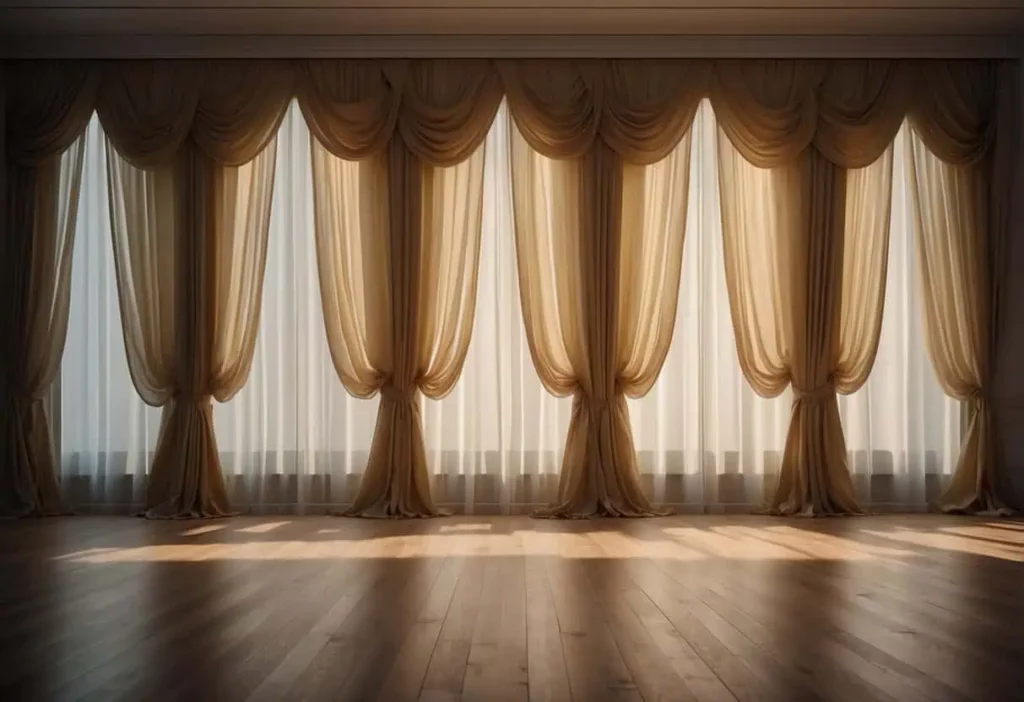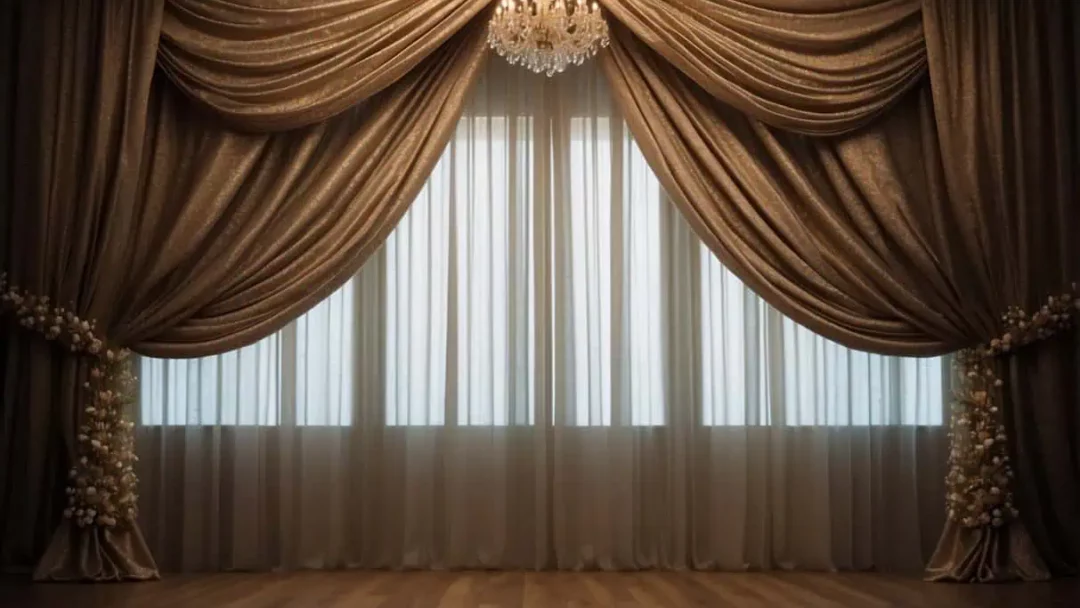Draping curtains for a backdrop can transform an ordinary space into a visually appealing setup for events, photography, or even a home’s aesthetic decoration.
A well-designed curtain backdrop serves as a focal point and can add a sophisticated touch to various occasions.
This comprehensive guide aims to equip individuals with the necessary steps to ensure their backdrop not only stands out but is also set up efficiently and effectively.
Before embarking on creating a draped curtain backdrop, it is essential to understand the importance of choosing the right fabric and preparing it for installation.
The type of material used will influence the overall look and functionality of the backdrop.
Steaming or ironing the fabric prior to draping is crucial to eliminate any creases or wrinkles that could detract from the backdrop’s smooth appearance.
Successful draping is about artful execution and attention to detail, striking a balance between aesthetic allure and technical precision.
Positioning, securing, and styling the drapes are fundamental steps that contribute to a seamless and polished finished product.
Key Takeaways
- Proper preparation of the curtain fabric is essential for a clean presentation.
- Choosing the appropriate fabric and hardware influences the backdrop’s effectiveness and appeal.
- The drape styling techniques can significantly enhance the visual impact of the backdrop.
Understanding Curtain Backdrops
Curtain backdrops transform spaces for various events, providing a visual focal point and enhancing the overall aesthetic.
Fabric choice and drape style play pivotal roles in setting the appropriate tone for an event.
Backdrop Fundamentals
A backdrop serves as a key decorative element, often establishing the theme or atmosphere of an event.
They are essential for photo booths, stages, and as decorative walls at weddings and trade shows.
The fundamentals of a backdrop involve a sturdy framework and a method of securing the fabric, such as with clamps or ties, to ensure it hangs correctly and safely.
Types of Fabric
The type of fabric chosen for a backdrop affects the texture and appearance of the finished drape. Common fabrics include:
- Polyester: Versatile and wrinkle-resistant, polyester offers a smooth look.
- Velvet: Adds a rich, luxurious texture, often used for upscale events.
- Muslin: A lightweight cotton fabric, ideal for simple, rustic themes.
Each fabric brings a different weight, sheen, and transparency to the backdrop, influencing its ability to fold, pleat, and hang properly.
Selection Based on Event Type
Selecting the appropriate fabric and style of drape is key to enhancing the event’s theme:
- Weddings: Often feature soft, sheer fabrics that add romance and elegance.
- Photo Booths: Typically use vibrant colors and patterns to create fun, engaging backdrops.
- Trade Shows: Utilize professional and branded backdrops to promote business identity.
Curtain backdrops must align with the event’s purpose, whether creating an intimate setting or a professional showcase.
Designing Your Backdrop
Creating a stunning backdrop involves thoughtful consideration of color schemes, space dimensions, and fabric textures to ensure that the final display complements the event’s theme effortlessly.
Choosing a Color Scheme
One must select a color palette that aligns with the event, such as a wedding, where whites, creams, or pastels are often preferred to create a classic and elegant look.
For a more vibrant setting, one might consider a variety of colors to add energy and excitement.
Using consistent, theme-related hues can significantly enhance the visual appeal of a backdrop.
- Weddings: Whites, creams, pastels
- Vibrant Settings: Reds, yellows, blues, greens
- Thematic Events: Color coordinated with event theme
Space and Sizing Considerations
The size of the venue dictates the width and height of the backdrop.
Ample space allows for grand, expansive backdrops, whereas limited areas might require more compact dimensions.
Optimal backdrop size ensures it is neither overshadowed by the surrounding space nor does it overpower the event setting.
- Large Venues:
- Width: Equal to or greater than stage width
- Height: As tall as the ceiling allows
- Intimate Venues:
- Width: Proportionate to performance or focal area
- Height: Adjusted to avoid cramped look
Selecting the Right Texture
The texture of the curtain fabric should be chosen to reflect the desired atmosphere of the event.
Smooth, sheer fabrics often convey a soft, romantic feel, ideal for weddings, while rich, velvety textures might be used for more opulent affairs.
Textured fabrics add depth and complexity, providing a visually dynamic backdrop.
- Wedding: Sheer, lightweight, smooth
- Opulent Affairs: Velvet, heavy drapes
- Visual Depth: Pleated, textured fabrics

Curtain Backdrop Setup Essentials
Creating a curtain backdrop involves careful selection of durable hardware and precise assembly. Knowing the essential components and the steps to put them together ensures a stable and elegant result.
Essential Hardware Components
To begin setting up a curtain backdrop, one needs the following items:
- Base Plates: The foundation of the structure, base plates should be heavy enough to provide stability. They typically come in various sizes and weights; larger backdrops require heavier bases for support.
- Upright Pipes: Vertical pipes that determine the height of the backdrop. They should be adjustable to accommodate different spaces and usually have slots for crossbar insertion.
- Crossbars: Horizontal bars that hold and support the drape fabric. They should be lightweight yet strong and come in telescoping styles to adjust to varying widths.
- Drapes: Fabric panels that will hang from the crossbar. Select materials that combine aesthetic appeal with practical durability.
Assembling Your Pipe and Drape System
- Construct the Base:
- Securely attach the base plate to the upright pipe. Some systems utilize a screw-in mechanism, while others may have a slip-fit connection.
- Ensure each base is properly weighted to withstand the fabric’s pull and any incidental contact during the event.
- Adjust Height:
- Set the upright pipes to the desired height before attaching the crossbar, considering the event space and the backdrop design.
- Make sure the height is consistent across all uprights for a uniform appearance.
- Attach the Crossbar:
- Insert the crossbar into the top slots of the upright pipes. If using a telescoping crossbar, adjust it to the necessary width before securing it in place.
- Confirm the crossbar is securely fastened and level to prevent any sagging of the fabric.
Styling Your Curtain Drapes
When styling curtain drapes for a backdrop, the careful creation of pleats and folds as well as the addition of decorative elements can transform a simple curtain into an elegant and luxurious focal point for any event.
Creating Pleats and Folds
To achieve a sophisticated look, one should focus on constructing precise pleats and folds in the fabric.
Starting with a flat, wrinkle-free canvas is essential; therefore, ironing or steaming the fabric beforehand is recommended.
Pleating involves folding the material in regular intervals, securing each pleat at the top with clips or ties for consistency.
Adding variety to the pleat sizes can add depth and texture, making the backdrop more visually appealing.
Remember, symmetry and uniformity in the spacing of pleats can enhance the overall elegance of the drapes.
- Regular Pleating: Evenly spaced pleats for a classic look.
- Varied Pleating: A combination of different pleat sizes for a dynamic effect.
Adding Decorative Elements
One can elevate the luxurious feel of the curtains by incorporating decorative elements.
Adding flowers, either fresh or artificial, can introduce a natural and vibrant touch.
Position flowers strategically to serve as a focal point or to accentuate certain areas of the backdrop.
Other embellishments can include:
- Crystal Beads: For a touch of glamour.
- Fairy Lights: To add a soft, ambient glow.
- Fabric Swags: Additional layers of fabric draped elegantly to add fullness.
The integration of these elements needs to be done carefully, ensuring they complement the event’s theme and color scheme without overpowering the curtains’ inherent style.
Fabric Considerations
When selecting fabric for a backdrop, the two main factors to consider are the fabric’s weight and its safety features, such as fire resistance.
Choosing Between Sheer and Heavy Fabrics
Sheer Fabrics like chiffon and voile allow light to pass through, giving a soft and airy feel to the backdrop.
They are an excellent choice for creating a delicate and ethereal ambiance.
These lightweight materials are easy to handle and can add a stylish touch to the event’s decor. However, they may require more layers to prevent transparency.
- Chiffon: Often used for a wispy look, ideal for weddings or romantic settings.
- Voile: A bit more structured than chiffon, good for a clean appearance while maintaining a light feel.
Heavier Fabrics like velvet and satin offer a more dramatic and luxurious backdrop.
They are typically opaque and do not need layering. Heavier materials drape smoothly and have a commanding presence.
Fire Safety and Fabric Treatment
Fire Safety is imperative for any event.
Fabrics used for backdrops should be inherently fire retardant or treated with a fire-retardant solution.
Always check for:
- Compliance with local fire codes.
- Certificates that prove the fabric’s fire-resistant properties.
Fabric Treatment can also enhance a material’s safety and performance.
Applying a fire-retardant treatment can prevent rapid ignition and flame spread.
Some fabrics come pre-treated, whereas others may require a separate application.
- Sheer Fabrics: Might need special treatment as their lightweight nature makes them more susceptible to damage.
- Heavier Fabrics: Though less flammable, must still adhere to fire safety standards, especially in public spaces.
Lighting and Visibility
When draping curtains for a backdrop, integrating lighting can enhance the backdrop’s visual appeal.
Meanwhile, the transparency and material of the fabric will affect how light interacts with the curtains.
Strategic lighting choices can amplify the aesthetic, whether for a romantic ceremony or a vibrant reception.
Incorporating Lighting Elements
For a backdrop to captivate attention effectively, lighting elements are essential.
They recommend carefully stringing curtain lights over rods, securing them in place with discreet tape.
By starting at the floor, draping lights over the rod, and allowing them to cascade back down creates a luminous effect.
When lights are interwoven with the fabric, it creates a romantic ambiance, highly desirable in settings such as wedding ceremonies or intimate gatherings.
Adjusting for Transparency and Material
The curtain material’s transparency influences visibility and the interplay with light.
Sheer fabrics diffuse light softly, adding a delicate touch suitable for wedding receptions.
Here is how to adjust for different materials:
- Opaque Fabrics: Ensure that lighting is placed directly on or in front of the fabric to prevent shadowing.
- Sheer Fabrics: Position lights behind the fabric to create a silhouette or soft glow.
They should always select a fabric that complements the event’s lighting design—whether bright and festive or muted and sophisticated—to maximize the backdrop’s impact.

Best Practices for Curtain Draping
When draping curtains for a backdrop, the ultimate goal is to achieve an elegant appearance that complements the event’s theme.
Precision in measuring, cutting, and securing the fabric ensures a professional and captivating result.
Measuring and Cutting Techniques
For an exact fit, one must carefully measure the width of the area to determine the amount of fabric needed.
This includes accounting for pleats or folds if a fuller look is desired.
It’s recommended to measure the height from the upright to the floor to ascertain the curtain length, adding extra inches for pooling if one chooses that effect.
Fabric should be cut evenly and without fraying edges.
Utilize quality scissors or fabric cutters and a clean work surface to avoid inaccuracies.
- Measure Width: Total area width + additional % for folds
- Measure Height: Upright to floor + extra inches for pooling (if desired)
Securing and Tying Backdrops
Securing the drape starts with the proper installation of the hardware.
Attach fabric securely at the top, often to a crossbar with clips or ties, making certain that it is evenly distributed.
Tying backdrops can be influenced by personal preference and event style; some may choose a simple, straight hang, while others opt for creative tie-backs or swags.
The fabric’s pockets, where present, should be free of obstructions to ensure smooth gathering and elegant lines.
- Secure Top: Use clips/ties to fasten fabric to crossbar
- Tie-backs or Swags: Based on personal preference and style
Budget considerations also dictate the type of fabric and hardware one selects, as well as the complexity of the draping technique used.
Remember to work within one’s financial means to achieve the desired backdrop.
Frequently Asked Questions
In this section, answers to common questions about draping curtains for backdrops are provided, offering guidance on fabric selection, method, and design tips.
What is the recommended fabric length for creating a curtain backdrop?
To ensure a full and elegant drape, one typically needs a fabric that’s twice the height of the space.
Extra length allows for adequate coverage and attractive pooling on the floor if desired.
What are some creative ways to hang curtains for a photo backdrop?
One can use a variety of methods such as pipe and drape systems, tension rods, or even fishing lines and hooks for a floating effect.
The method chosen will depend on the desired aesthetic and the venue’s limitations.
How do I securely drape curtains for an event backdrop without causing damage to the wall?
Adhesive hooks, temporary command strips, or freestanding backdrop frames are effective for securing curtains without causing harm to walls.
Always follow the product’s instructions for the best results.
What type of fabrics work best for a wedding ceremony backdrop?
Sheer fabrics like voile and chiffon create romantic and airy backdrops, while satins provide a more lustrous and formal look.
The choice should complement the wedding’s overall theme and color palette.
Can you provide tips for incorporating tulle into a curtain backdrop design?
Tulle offers a whimsical and lightweight texture to backdrops.
Layering it over another fabric or using it to create distinct sections within a backdrop adds depth and visual interest to the design.
What are some effective methods for creating a festive backdrop with curtains for a birthday party?
Bright and colorful fabrics or those with patterns can enhance the festive atmosphere.
Adding string lights, balloons, or themed decor can further personalize the backdrop for the celebration.

